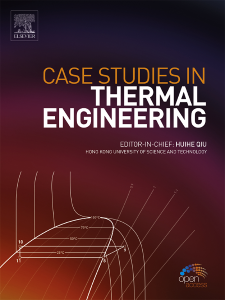Numerical investigation on thermal performance of three configurations of solar thermal collector integrated with metal hydride
IF 6.4
2区 工程技术
Q1 THERMODYNAMICS
引用次数: 0
Abstract
This study investigates the optimal configuration of a Metal Hydride-based Solar Thermal Collector (MH-STC) by developing a transient 3D mathematical model to simulate three distinct configurations: C1, C2, and C3. These configurations differ in the placement of water pipes within the metal hydride bed C1 features pipes in the top region, C2 in the core zone, and C3 at the bottom. The performance of these configurations was rigorously compared based on hydrogen charge state, outlet water temperature, useful energy output, and thermal efficiency across varying water flow rates. Results reveal that configuration C1 achieves superior thermal performance during daytime operation, producing outlet temperatures up to 10 °C higher than the other configurations. Conversely, configuration C3 excels at nighttime heating, delivering water temperatures approximately 11.5 °C higher than C1. Furthermore, the analysis indicates that hydrogen desorption pressure significantly impacts outlet water temperature; for instance, increasing the pressure from 2.41 bar to 6 bar enhances the average outlet temperature of the C3 design by about 20 °C during the day and reduces it by approximately 15 °C at night. These findings highlight the critical need for optimizing solar collector designs to effectively meet the thermal demands of both daytime and nighttime applications.
对集成了金属氢化物的三种太阳能集热器配置的热性能进行数值研究
本研究通过建立一个瞬态三维数学模型来模拟三种不同的配置,从而研究基于金属水化物的太阳能集热器(MH-STC)的最佳配置:C1、C2 和 C3。这些配置的不同之处在于水管在金属氢化物床中的位置,C1 在顶部区域,C2 在核心区域,C3 在底部。根据氢荷状态、出口水温、有用能量输出和不同水流量下的热效率,对这些配置的性能进行了严格比较。结果表明,配置 C1 在白天运行时具有卓越的热性能,其出水温度比其他配置高出 10 °C。相反,配置 C3 在夜间加热时表现出色,出水温度比 C1 高出约 11.5 °C。此外,分析表明,氢解吸压力对出水温度有显著影响;例如,将压力从 2.41 巴提高到 6 巴,C3 设计的平均出水温度在白天会提高约 20 °C,而在夜间则会降低约 15 °C。这些发现凸显了优化太阳能集热器设计以有效满足白天和夜间应用的热需求的迫切需要。
本文章由计算机程序翻译,如有差异,请以英文原文为准。
求助全文
约1分钟内获得全文
求助全文
来源期刊

Case Studies in Thermal Engineering
Chemical Engineering-Fluid Flow and Transfer Processes
CiteScore
8.60
自引率
11.80%
发文量
812
审稿时长
76 days
期刊介绍:
Case Studies in Thermal Engineering provides a forum for the rapid publication of short, structured Case Studies in Thermal Engineering and related Short Communications. It provides an essential compendium of case studies for researchers and practitioners in the field of thermal engineering and others who are interested in aspects of thermal engineering cases that could affect other engineering processes. The journal not only publishes new and novel case studies, but also provides a forum for the publication of high quality descriptions of classic thermal engineering problems. The scope of the journal includes case studies of thermal engineering problems in components, devices and systems using existing experimental and numerical techniques in the areas of mechanical, aerospace, chemical, medical, thermal management for electronics, heat exchangers, regeneration, solar thermal energy, thermal storage, building energy conservation, and power generation. Case studies of thermal problems in other areas will also be considered.
 求助内容:
求助内容: 应助结果提醒方式:
应助结果提醒方式:


